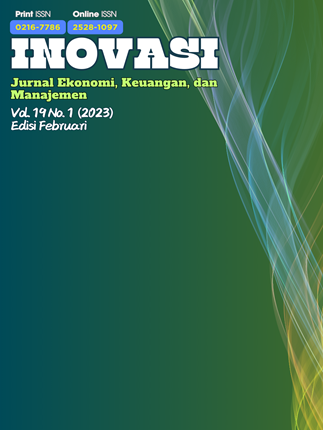Company performance improvement: implementation of service culture through human capital in hospitality industry
DOI:
https://doi.org/10.30872/jinv.v19i1.2453Keywords:
Company performance, hospitality industry, human capital, service cultureAbstract
The process of improving service productivity in the hotel industry is of course caused by several fundamentally important factors, including corporate culture and employee human resources factors. A good organizational culture should have the core characteristics of being firmly supported, well-managed, and shared as a whole. Problems commonly faced by employees are related to how to proactively adapt to the company culture so that conflicts do not occur. The research instrument was a questionnaire distributed to 192 hotel employees in West Java, Indonesia. This research aims to conclude whether human capital can mediate the influence of service culture by increasing company performance. The research method used is a simple regression analysis using SPSS and Amos as a calculation tool. The results show that human capital can mediate the influence between service culture and increased company performance in the hotel industry
References
Al-Najjar, S. M., & Kalaf, K. H. (2012). Designing a Balanced Scorecard to Measure a Bank’s Performance: A Case Study. International Journal of Business Administration, 3(4), 44–53. https://doi.org/10.5430/ijba.v3n4p44
Andriani, R., Disman, Ahman, E., Yuniarsih, T., & Santoso, B. (2019). Polychronic Behaviors: The Role Of Job Residency and Education Level. International Journal of Entrepreneurship, 23(3), 1–5. https://www.abacademies.org/articles/Polychronic-behaviors-the-role-of-job-residency-and-education-level-1939-4675-23-3-297.pdf
Andriani, R., & Disman, D. (2020). Polychronicity in the Hotel Industry in Bandung City. In Advances in Business, Management and Entrepreneurship. Taylor & Francis Group.
Baron, R. M., & Kenny, D. a. (1986). The Moderator-Mediator Variable Distinction in Social The Moderator-Mediator Variable Distinction in Social Psychological Research: Conceptual, Strategic, and Statistical Considerations. Journal of Personality and Social Psychology, 51(6), 1173–1182. https://doi.org/10.1037/0022-3514.51.6.1173
Bonn, M. A., & Forbringer, L. R. (1992). Reducing turnover in the hospitality industry: an overview of recruitment, selection and retention. International Journal of Hospitality Management, 11(1), 47–63. https://doi.org/10.1016/0278-4319(92)90035-T
Boswell, W. R., Roehling, M. V., LePine, M. A., & Moynihan, L. M. (2003). Individual job-choice decisions and the impact of job attributes and recruitment practices: A longitudinal field study. Human Resource Management, 42(1), 23–37. https://doi.org/10.1002/hrm.10062
Choi Heh, J., & Choi Seung, L. (2006). F-3 The Study on the Family Precepts of the Rich Chois in KyoungJoo. 経営行動科学学会年次大会 : 発表論文集, 63(9), 138–154.
Curtis, B., Krasner, H., & Iscoe, N. (1988). A field study of the software design process for large systems. Communications of the ACM, 31(11), 1268–1287. https://doi.org/10.1145/50087.50089
Davenport, T. H., Long, D. W. De, & Beers, M. C. (1998). Successful Knowledge Management Projects (citation wrong). Sloan Managemenl Review, 93(5), 487–493. https://doi.org/10.1016/j.ygeno.2009.01.004
Edvinsson, L., & Sullivan, P. (1996). Developing a model for managing intellectual capital. European Management Journal, 14(4), 356–364. https://doi.org/10.1016/0263-2373(96)00022-9
Francis, H., & D’Annunzio-Green, N. (2005). HRM and the pursuit of a service culture: Managerial encounters with competing discourses. Employee Relations, 27(1), 71–85. https://doi.org/10.1108/01425450510569319
Harahap, Z. (2017). Pengaruh Peran Kepemimpinan, Komunikasi dan Kompensasi terhadap Kepuasan Kerja serta implikasinya pada kinerj a karyawan yang dimoderasi oleh Keterikatan Kerj a Karyaw an. (survey pada hotel bintang 4 dan 5 di Jaw a Barat). Universitas Pasundan.
Jarboui, S., Guetat, H., & Boujelbène, Y. (2015). Evaluation of hotels performance and corporate governance mechanisms: Empirical evidence from the Tunisian context. Journal of Hospitality and Tourism Management, 25, 30–37. https://doi.org/10.1016/j.jhtm.2015.08.002
Knights, D., Morgan, G., & Knights, D. (1992). Corporate Strategy , Organizations , Subjectivity : A Critique. Organisation Studies, 12(2), 251–273.
Krechovská, M., & Procházková, P. T. (2014). Sustainability and its integration into corporate governance focusing on corporate performance management and reporting. Procedia Engineering, 69, 1144–1151. https://doi.org/10.1016/j.proeng.2014.03.103
Krott, M., Bader, A., Schusser, C., Devkota, R., Maryudi, A., Giessen, L., & Aurenhammer, H. (2014). Actor-centred power: The driving force in decentralised community based forest governance. Forest Policy and Economics, 49, 34–42. https://doi.org/10.1016/j.forpol.2013.04.012
Mcvea, J. F., & Freeman, R. E. (2005). A names-and-faces approach to stakeholder management how focusing on stakeholders as individuals can bring ethics and entrepreneurial strategy together. Journal of Management Inquiry, 14(1), 57–69. https://doi.org/10.1177/1056492604270799
Noerchoidah, & Harjanti, D. (2019). EXPLORING THE RELATIONSHIP BETWEEN PROCEDURAL JUSTICE AND INNOVATIVE WORK BEHAVIOR IN HOSPITALITY INDUSTRY. Jurnal Manajemen Dan Kewirausahaan, 21(1), 21–31. https://doi.org/10.9744/jmk.21.1.21
Patterson, M., Warr, P., & West, M. (2004). Organizational_Climate_and_Company_Productivity_the_Role_of_Employee_Affect_and_Employee_Level.pdf. The London School of Ecoomic and Political Science, 626.
Pike, S., Fernström, L., & Roos, G. (2005). Intellectual capital. Journal of Intellectual Capital, 6(4), 489–509. https://doi.org/10.1108/14691930510628780
Preacher, K. J., & Hayes, A. F. (2004). SPSS and SAS procedures for estimating indirect effects in simple mediation models. Behavior Research Methods, Instruments, and Computers, 36(4), 717–731. https://doi.org/10.3758/BF03206553
Pulic, A. (2000). VAICTM – An accounting tool for intellectual capital management. International Journal Technology Management, 20(5/6/7/8), 702–714.
Putri, G. F. (2016). Pengaruh mutasi kerja terhadap kinerja karyawan operasional di vio cihampelas hotel bandung. Sekolah Tinggi Pariwisata Bandung.
Quélin, B., & Duhamel, F. (2003). Bringing together strategic outsourcing and corporate strategy: Outsourcing motives and risks. European Management Journal, 21(5), 647–661. https://doi.org/10.1016/S0263-2373(03)00113-0
Quinn, B., Anderson, P., Finkelstein, S., & Quinn, J. B. (1996). Intellect : Making the Most of the Best. Harward Business Reivew, 74(2), 71–80.
Ramachandran, V. S. (2000). Mirror neurons and imitation learning as the driving force behind “the great leap forward” in human evolution. Edge.Org, 1–7. https://doi.org/www.edge.org/documents/archive/edge69.html
Sainaghi, R., & Baggio, R. (2014). Structural social capital and hotel performance: Is there a link? International Journal of Hospitality Management, 37, 99–110. https://doi.org/10.1016/j.ijhm.2013.11.004
Salvatore T. March *, G. F. S. (1964). on Botryoid Sarcoma (Mesodermal Mixed Tumor) in the Perineal Region in Infant. Gan No Rinsho. Japan Journal of Cancer Clinics, 10, 501–509. https://doi.org/10.1016/0167-9236(94)00041-2
Valarie A. Zeithaml, Leonard L. Berry, & A. P. C. (2011). Communication Processes in the Delivery of Service Quality. Journal of Marketing, 52(2), 35–48.
Valentine, S., Godkin, L., Fleischman, G. M., & Kidwell, R. (2011). Corporate Ethical Values, Group Creativity, Job Satisfaction and Turnover Intention: The Impact of Work Context on Work Response. Journal of Business Ethics, 98(3), 353–372. https://doi.org/10.1007/s10551-010-0554-6
Wiley, J. (2011). Strategy Process Research : Focusing on Corporate Self-Renewal. Managing, 13, 5–14. https://doi.org/10.1016/j.optmat.2010.09.020
Zuckerman, E. W. (2000). Focusing the corporate product: Securities analysts and de-diversification. Administrative Science Quarterly, 45, 591–619. https://doi.org/10.2307/2667110
Downloads
Published
Issue
Section
License
Copyright (c) 2025 Rian Andriani, Purwadhi Andriani, Disman Andriani

This work is licensed under a Creative Commons Attribution-ShareAlike 4.0 International License.






